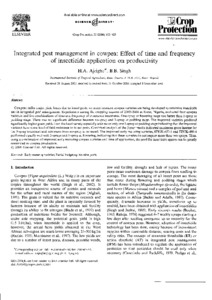| dc.contributor.author | Ajeigbe, Hakeem A. |
| dc.contributor.author | Singh, B.B. |
| dc.date.accessioned | 2019-12-04T11:18:06Z |
| dc.date.available | 2019-12-04T11:18:06Z |
| dc.date.issued | 2006 |
| dc.identifier.citation | Ajeigbe, H.A. & Singh, B.B. (2006). Integrated pest management in cowpea: effect of time and frequency of insecticide application on productivity. Crop Protection, 25(9), 920-925. |
| dc.identifier.issn | 0261-2194 |
| dc.identifier.uri | https://hdl.handle.net/20.500.12478/3053 |
| dc.description.abstract | Cowpeas suffer major yield losses due to insect pests, so insect resistant cowpea varieties are being developed to minimize insecticide use in integrated pest management. Experiments during the cropping seasons of 2002–2004 at Kano, Nigeria, evaluated four cowpea varieties and five combinations of time and frequency of insecticide treatments. One-spray at flowering stage was better than 1-spray at podding stage. There was no significant difference between no-spray and 1-spray at podding stage. The improved varieties produced significantly higher grain yields than the local variety especially with no or only one 1-spray at podding stage indicating that the improved varieties have some level of field resistance to insect pests. Combined analysis of the 3-year results indicated maximum gross income for the 3-spray treatment and minimum from no-spray as expected. The improved early maturing varieties, IT93K-452-1 and IT97K-499-4 performed equally well with 2-sprays and 1-spray at flowering, indicating that these varieties do not require more than two sprays. Thus, using a combination of improved early maturing cowpea varieties and time of application, the need for insecticide sprays can be greatly minimized in cowpea production. |
| dc.language.iso | en |
| dc.subject | Early Maturing Varieties |
| dc.subject | Partial Budgeting |
| dc.subject | Relative Profit |
| dc.subject | Cowpeas |
| dc.subject | Podding Stage |
| dc.subject | Insect Pest |
| dc.subject | Soil Fertility |
| dc.subject | Insecticide |
| dc.title | Integrated pest management in cowpea: effect of time and frequency of insecticide application on productivity |
| dc.type | Journal Article |
| dc.description.version | Peer Review |
| cg.contributor.affiliation | International Institute of Tropical Agriculture |
| cg.coverage.region | Africa |
| cg.coverage.region | West Africa |
| cg.coverage.country | Nigeria |
| cg.isijournal | ISI Journal |
| cg.authorship.types | CGIAR single centre |
| cg.iitasubject | Farm Management |
| cg.iitasubject | Agronomy |
| cg.iitasubject | Integrated Soil Fertility Management |
| cg.iitasubject | Soil Fertility |
| cg.iitasubject | Soil Health |
| cg.iitasubject | Research Method |
| cg.iitasubject | Impact Assessment |
| cg.iitasubject | Soil Information |
| cg.iitasubject | Disease Control |
| cg.iitasubject | Pests Of Plants |
| cg.iitasubject | Aflatoxin |
| cg.iitasubject | Plant Breeding |
| cg.iitasubject | Plant Diseases |
| cg.accessibilitystatus | Limited Access |
| local.dspaceid | 94519 |
| cg.identifier.doi | https://dx.doi.org/10.1016/j.cropro.2005.12.003 |

